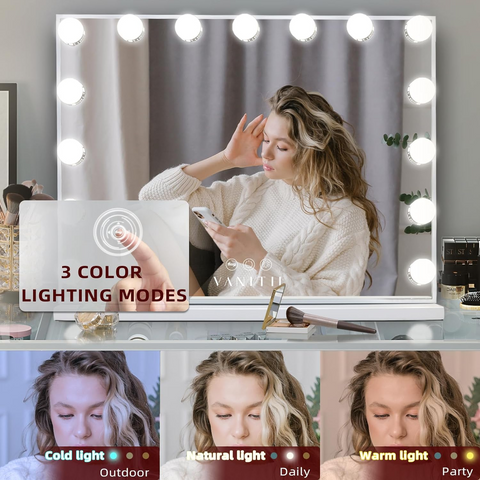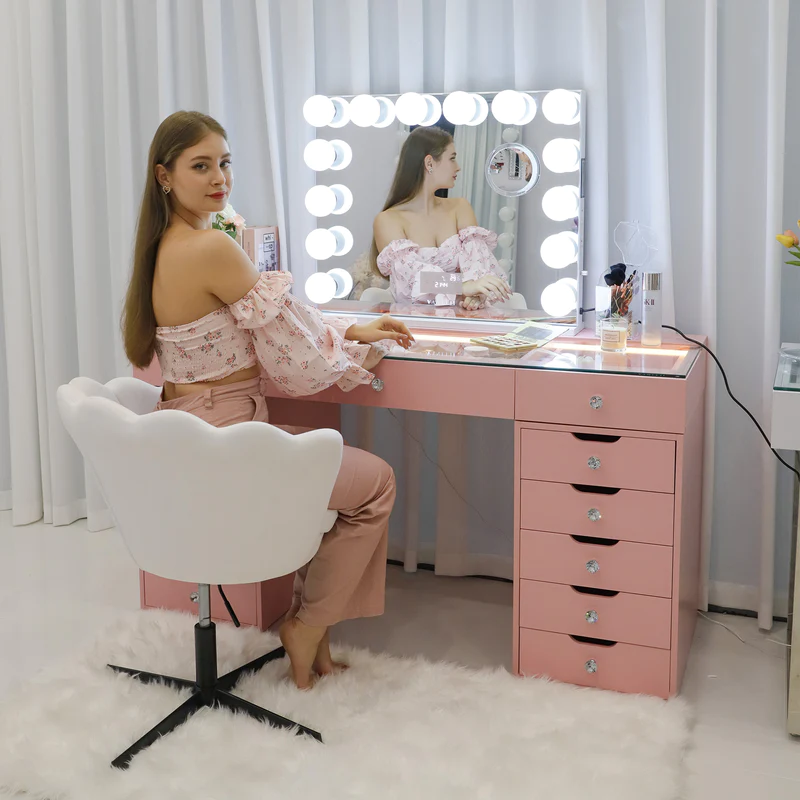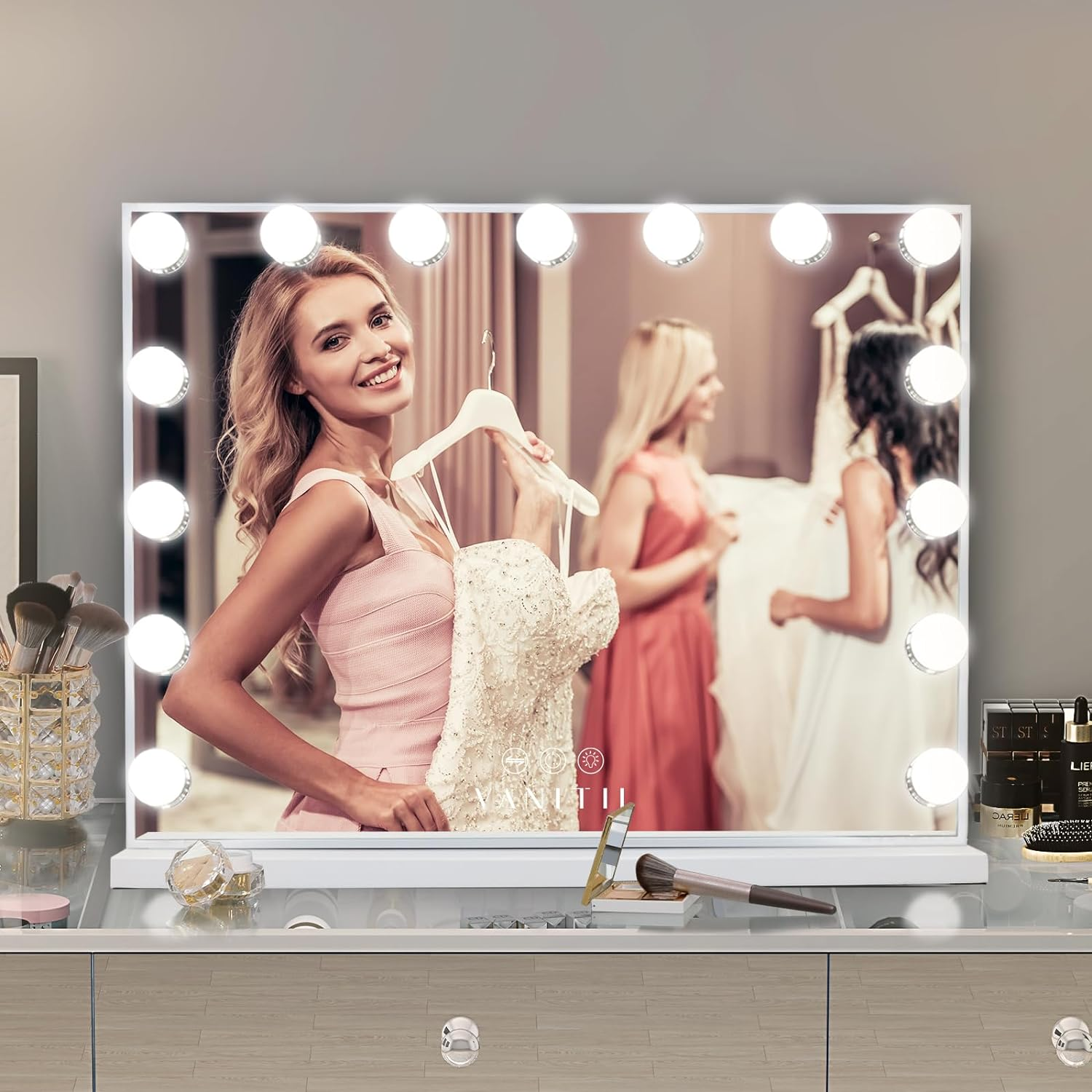Applying makeup in a mirror that shows reflections clearly and accurately allows you to get your look just right. But bent and uneven reflections make it really hard to see if your makeup is balanced or needs fixing. Good quality mirrors don't bend the reflections and show your true makeup results. This article explains what makes mirrors show funny reflections, how to pick a good clear makeup mirror so you can do your makeup properly, and how to take care of it so it stays crystal clear. Read on for tips so you can see plainly what your makeup is really looking like and master that perfect look!

What Is Distortion and How Does It Happen?
Mirror distortion happens when the reflection shown in the mirror isn't an exact match to the real object. Often the differences are subtle - a slight bend, unevenness, or waviness. You may have to look closely to notice something is "off." For an accurate reflection, light rays need to bounce off at precise calculated angles. If the mirror's surface has any tiny defects, inconsistencies, or flaws, those light angles get thrown off, resulting in the reflection becoming a funhouse version of reality.
1. Common Types of Distorted Reflections
There are three most common types of distortion you may encounter:
- Barrel Distortion: Makes straight lines appear subtly curved outwards, like the bulging shape of a barrel. The edges of the reflection may look stretched outward. This gives faces or objects a wider, rounded look.
- Pincushion Distortion: The opposite of barrel distortion. Instead of bulging out, straight lines bend slightly inwards like the center of a pincushion. This makes edges appear compressed and leaned inward. Faces may look narrower.
- Wave Distortion: The reflection lacks smoothness and appears choppy or rippled. Straight lines look wavy instead of straight. Gives the reflection an uneven, warped appearance.
2. What Cause Distorted Mirror Images?
Low material quality, poor manufacturing techniques, impact on framing, humidity/temperature fluctuations, and improper mounting can all contribute to distortion forming over time. Taking precautions during production and properly caring for mirrors helps minimize risks. Even tiny variances or flaws on the reflective surface make light rays scatter at odd angles rather than accurately showing reality. This is what causes weird bends, unevenness, and waviness instead of pristine reflections.choosing a vendor known for high standards becomes essential. In this realm, vanitii is recognized for providing the best quality Hollywood vanity mirrors, blending superior materials and craftsmanship to deliver mirrors that offer flawless reflections.
Types of Vanity Mirrors and Distortion Traits
There are three main kinds of mirrors used for putting on makeup, each with its own distortion risks.

1. Common Vanity Mirror Types
- Wall-Mounted Mirrors: Mounted directly on the wall for hands-free use while applying makeup.
- Tabletop Mirrors: Sitting on a counter or tabletop and able to be adjusted and moved around.
- Magnified Mirrors: Feature zoom-in capabilities allowing you to see tiny makeup details up close.
If you find yourself weighing up these options, consider diving deeper into the advantages of each with our guide on Choosing Between Wall-Mounted and Compact Makeup Mirrors.
2. Which Types are More Distortion-Prone?
Wall mounts tend to be more vulnerable to distortion since flaws in mounting and installation can bend or torque the frame. Tabletops avoid wall issues but can start to develop small flaws over time with frequent handling. Magnifying mirrors bend light through more layers of glass and angles, increasing the chances of uneven reflections.
3. How Materials Impact Clarity
Common mirror materials affect image accuracy:
- Glass: Classic mirrored glass offers undistorted reflections of high quality.
- Acrylic: Plastic acrylic provides good clarity but scratches easier.
- Polished metal: Can look pristine when new but tarnishes over time.
- Mirrored coatings on glass: Quality varies, less stable than solid mirrors.
Extra elements like decorative frames or magnification impact distortion potential as well. Knowing your mirror's qualities helps combat issues.
How to Spot and Test for Distortion
Luckily, there are some simple techniques you can use to proactively check for distortion in a mirror, whether you're testing out a mirror in a store or examining one you already own.
1. Easy At-Home Test Methods
Visually inspect the mirror reflection from multiple distances and angles:
- Stand close to the mirror, then farther back - does anything look uneven, stretched, or compressed?
- Observe your reflection while moving from side to side. The distortion often shows only from an off-center angle.
- Have someone else look at the reflection to catch distortions you can't see head-on.
- Shine light from different directions - distortion is often easier to spot when light hits imperfections.
- Study facial feature balance/symmetry - do proportions look accurate?
2. Grid Test with String
Tape a tic-tac-toe grid of string onto the mirror surface. Step back and move side to side, looking for any grid sections that appear larger, smaller, or box shapes that seem bent. Carefully remove the string and check if the residual grid outline still looks perfectly straight.
3. Straight Line Test
Hold up a ruler, laser level, or carpenter's level vertically and horizontally across the mirror. Note any areas where the reflection makes straight lines appear subtly curved or wavy. For easy retesting, use dry erase marker to trace faint straight reference lines right on the mirror.
Checking a mirror regularly from multiple angles and in different lighting conditions allows early detection of distortion issues while still minor and correctable.
How to Choose the Right Mirror to Avoid Distortion
When picking out a new vanity mirror, there are some important features and factors that indicate if a mirror is well-made enough to prevent uneven reflections.
1. What to Look For
Inspect closely for any visible flaws:
- Examine reflective surface near a light - are there any detectable scratches, streaks, or inconsistencies that could cause distortion?
- Check the backside and edges - is there previous damage? Cracked pieces?
- Tap gently to check for vibration tendencies hinting at instability.
- Solid glass mirrors avoid rippling better than hollow acrylic or plastic.
- Heavier stock mirrors on stable bases or reinforced wall anchors resist movement.
2. Brand Credibility and Reviews
Look for reputable brands offering warranties backing longevity claims. VANITII mirrors are well-known for exceptional build quality and clarity over years of use, avoiding bent image issues mentioned in some buyer reviews of cheaper alternatives.
3. Quality Standards and Certifications
Look for indicators that mirrors underwent regulated defect inspection and precision tolerance testing:
- "ISO Certified" and meets optical distortion manufacturing standards.
- Includes fire-safety mirror classifications to ensure heat performance passed testing.
- Manufactured in countries with compulsory quality control and export mirror screening enforcement results in properly calibrated reflection accuracy.
Vetting a mirror thoroughly beforehand avoids stylishly applying makeup in a funhouse reflection daily!
Care and Maintenance to Prevent Distortion Over Time
Taking good care of your makeup mirror keeps tiny flaws from slowly adding up into funky uneven reflections.
1. Caring Cleaning Methods
- Use super-soft microfiber cloths and gentle glass cleaner sprays for regular dusting to avoid scratches.
- Every few months, carefully wipe down with soft makeup brushes and mild cleaner solutions safe for mirrors.
- Completely dry all edges so water doesn't drip and pool at the frame.
- When cleaning, don't press hard on the reflective surface.
Humidity and big indoor temperature swings can subtly warp mirrors over many years. Keeping climate control stable protects mirrors. Check wall mounts haven't loosened on heavy mirrors.
2. Handy Maintenance Routines
- Gently dust mirrors weekly to clear away the grime that could start damaging reflective coatings.
- Carefully handle mirrors when relocating for deep cleaning to prevent nicks and dings.
- Immediately fix minor frame damage to keep structural integrity intact.
- Consider having mounting stability evaluated every few years to catch any loosening.
Staying on top of caring for your mirror ensures it keeps giving you an accurate reflection you can count on!

See Yourself Clearly for Makeup Success
Distortion in your makeup mirror makes it really hard to get your look just right. Bent and wavy reflections don't show your true makeup results. Knowing what flaws cause that funhouse look allows you to pick an accurate mirror. Checking for a nice clear reflection without subtle unevenness means you can trust what you see to apply your makeup flawlessly. Taking good care of your mirror keeps it showing the real you. That way, you can easily make your makeup look symmetrical and polished every time! With a distortion-free view in a well-kept mirror, you'll master that perfect makeup look.




Leave a comment
This site is protected by hCaptcha and the hCaptcha Privacy Policy and Terms of Service apply.